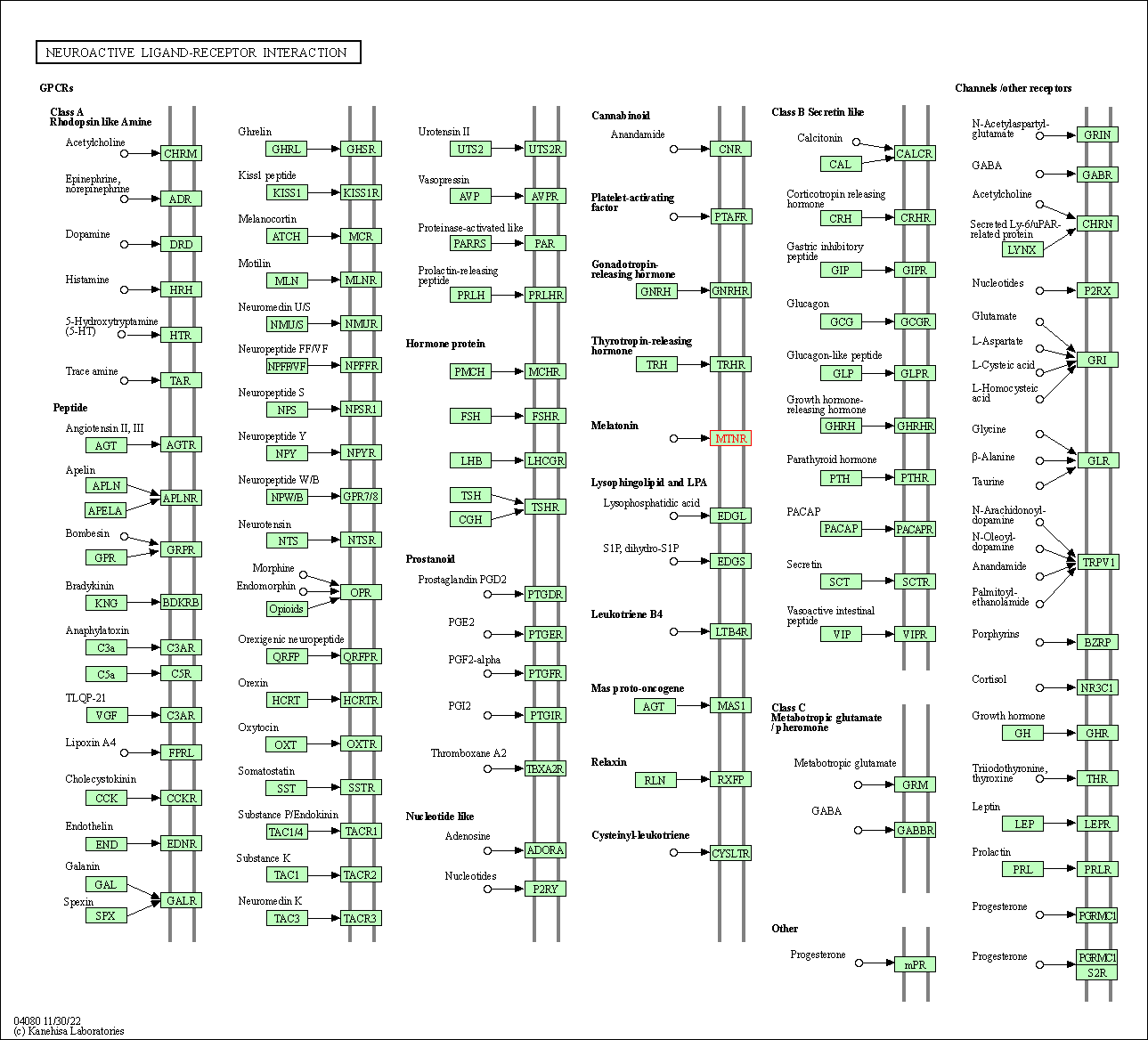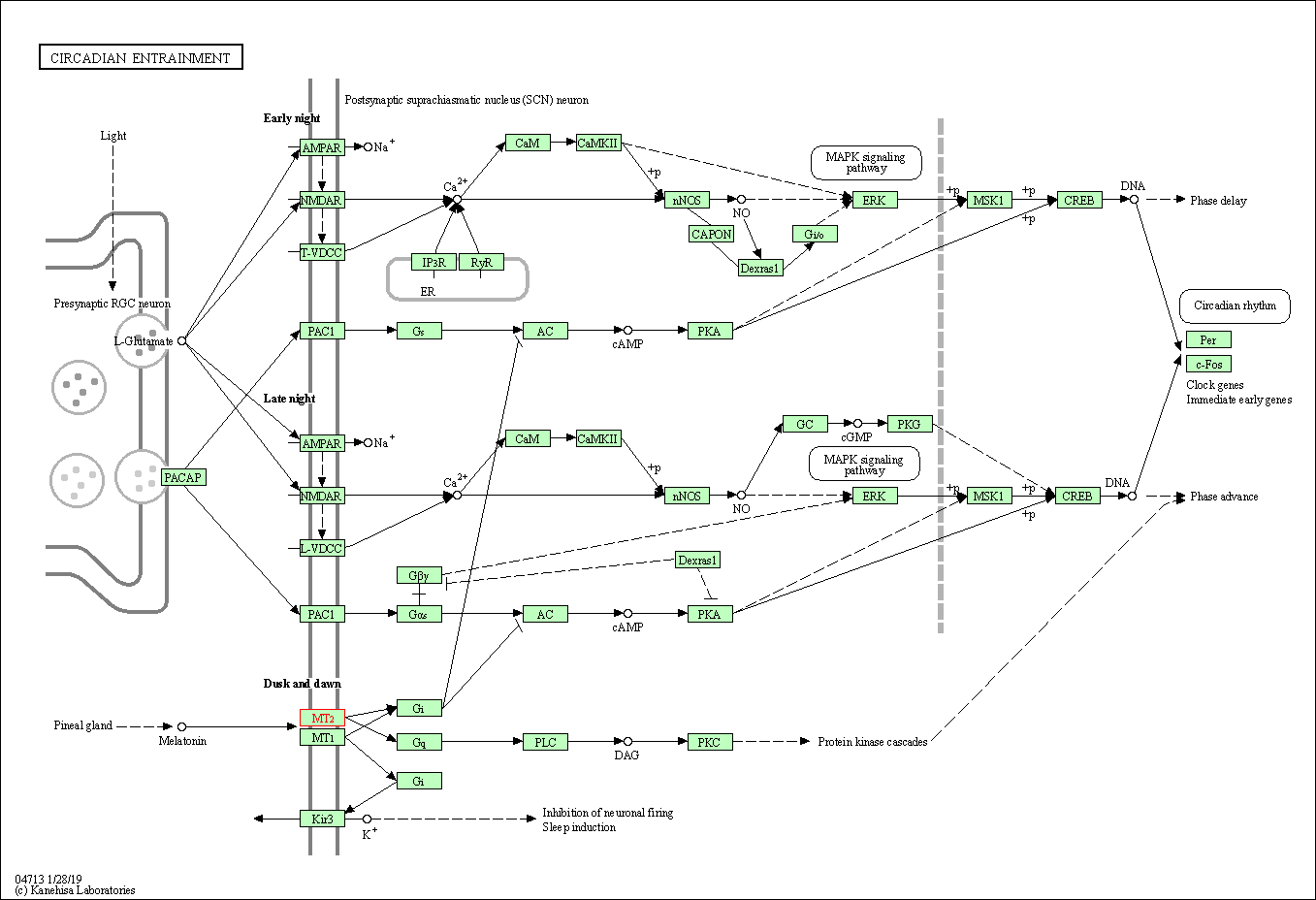Target Information
| Target General Information | Top | |||||
|---|---|---|---|---|---|---|
| Target ID |
T48268
(Former ID: TTDS00422)
|
|||||
| Target Name |
Melatonin receptor type 1B (MTNR1B)
|
|||||
| Synonyms |
Mel1b receptor; Mel1b melatonin receptor; Mel-1B-R
Click to Show/Hide
|
|||||
| Gene Name |
MTNR1B
|
|||||
| Target Type |
Successful target
|
[1] | ||||
| Disease | [+] 1 Target-related Diseases | + | ||||
| 1 | Insomnia [ICD-11: 7A00-7A0Z] | |||||
| Function |
Likely to mediate the reproductive and circadian actions of melatonin. The activity of this receptor is mediated by pertussis toxin sensitive G proteins that inhibit adenylate cyclase activity. High affinity receptor for melatonin.
Click to Show/Hide
|
|||||
| BioChemical Class |
GPCR rhodopsin
|
|||||
| UniProt ID | ||||||
| Sequence |
MSENGSFANCCEAGGWAVRPGWSGAGSARPSRTPRPPWVAPALSAVLIVTTAVDVVGNLL
VILSVLRNRKLRNAGNLFLVSLALADLVVAFYPYPLILVAIFYDGWALGEEHCKASAFVM GLSVIGSVFNITAIAINRYCYICHSMAYHRIYRRWHTPLHICLIWLLTVVALLPNFFVGS LEYDPRIYSCTFIQTASTQYTAAVVVIHFLLPIAVVSFCYLRIWVLVLQARRKAKPESRL CLKPSDLRSFLTMFVVFVIFAICWAPLNCIGLAVAINPQEMAPQIPEGLFVTSYLLAYFN SCLNAIVYGLLNQNFRREYKRILLALWNPRHCIQDASKGSHAEGLQSPAPPIIGVQHQAD AL Click to Show/Hide
|
|||||
| 3D Structure | Click to Show 3D Structure of This Target | PDB | ||||
| Drugs and Modes of Action | Top | |||||
|---|---|---|---|---|---|---|
| Approved Drug(s) | [+] 2 Approved Drugs | + | ||||
| 1 | Ramelteon | Drug Info | Approved | Insomnia | [2], [3] | |
| 2 | Tasimelteon | Drug Info | Approved | Insomnia | [1], [4] | |
| Clinical Trial Drug(s) | [+] 1 Clinical Trial Drugs | + | ||||
| 1 | VLB-01 | Drug Info | Phase 3 | Epilepsy | [5] | |
| Mode of Action | [+] 3 Modes of Action | + | ||||
| Modulator | [+] 2 Modulator drugs | + | ||||
| 1 | Ramelteon | Drug Info | [6], [7] | |||
| 2 | VLB-01 | Drug Info | [8] | |||
| Agonist | [+] 1 Agonist drugs | + | ||||
| 1 | Tasimelteon | Drug Info | [1] | |||
| Inhibitor | [+] 19 Inhibitor drugs | + | ||||
| 1 | 2-iodo-melatonin | Drug Info | [9] | |||
| 2 | 5-methoxycarbonylamino-N-acetyltryptamine | Drug Info | [10] | |||
| 3 | Beta,beta-dimethylmelatonin | Drug Info | [11] | |||
| 4 | Beta-methylmelatonin | Drug Info | [11] | |||
| 5 | N-(2,3,4,9-Tetrahydro-1H-carbazol-3-yl)-acetamide | Drug Info | [12] | |||
| 6 | N-(2-(5-methoxybenzofuran-3-yl)ethyl)acetamide | Drug Info | [10] | |||
| 7 | N-(3-(2,5-dimethoxyphenyl)propyl)acetamide | Drug Info | [13] | |||
| 8 | N-(3-(2-ethoxy-5-methoxyphenyl)propyl)acetamide | Drug Info | [13] | |||
| 9 | N-(3-(2-hydroxy-5-methoxyphenyl)propyl)acetamide | Drug Info | [13] | |||
| 10 | N-(3-(3-methoxyphenyl)-3-phenylallyl)acetamide | Drug Info | [14] | |||
| 11 | N-(3-(3-methoxyphenyl)propyl)acetamide | Drug Info | [13] | |||
| 12 | N-(3-(3-methoxyphenyl)propyl)propionamide | Drug Info | [13] | |||
| 13 | N-(3-(4-hydroxy-3-methoxyphenyl)propyl)acetamide | Drug Info | [13] | |||
| 14 | N-(3-(5-methoxy-2-propoxyphenyl)propyl)acetamide | Drug Info | [13] | |||
| 15 | N-(3-Benzooxazol-7-yl-propyl)-acetamide | Drug Info | [15] | |||
| 16 | N-(3-Benzooxazol-7-yl-propyl)-butyramide | Drug Info | [15] | |||
| 17 | N-(3-Benzooxazol-7-yl-propyl)-propionamide | Drug Info | [15] | |||
| 18 | N-[3-(2-Ethyl-benzooxazol-7-yl)-propyl]-acetamide | Drug Info | [15] | |||
| 19 | UCM-454 | Drug Info | [14] | |||
| Cell-based Target Expression Variations | Top | |||||
|---|---|---|---|---|---|---|
| Cell-based Target Expression Variations | ||||||
| Drug Binding Sites of Target | Top | |||||
|---|---|---|---|---|---|---|
| Ligand Name: Ramelteon | Ligand Info | |||||
| Structure Description | XFEL crystal structure of human melatonin receptor MT2 in complex with ramelteon | PDB:6ME9 | ||||
| Method | X-ray diffraction | Resolution | 3.30 Å | Mutation | Yes | [16] |
| PDB Sequence |
ADLEDNWETL
2010 NDNLKVIEKA2020 DNAAQVKDAL2030 TKMRAAALDA2040 QKATPPKLED2050 KSPDSPEMKD 2060 FRHGFDILVG2070 QIDDALKLAN2080 EGKVKEAQAA2090 AEQLKTTRNA2100 YIQKYLGDGA 34 RPSWVAPALS44 AVLIVTTAVD54 VVGNLLVILS64 VLRNRKLRNA74 GNLFLVSLAL 84 ANLVVAFYPY94 PLILVAIFYD104 GWAFGEEHCK114 ASAFVMGLSV124 IGSVWNITAI 134 AIDRYLYICH144 SMAYHRIYRR154 WHTPLHICLI164 WLLTVVALLP174 NFFVGSLEYD 184 PRIYSCTFIQ194 TASTQYTAAV204 VVIHFLLPIA214 VVSFCYLRIW224 VLVLQARMKK 1002 YTCTVCGYIY1012 NPEDGDPDNG1022 VNPGTDFKDI1032 PDDWVCPLCG1042 VGKDQFEEVE 1052 CLKPSDLRSF250 LTMFVVFVIF260 AICFAPLNCI270 GLAVAINPQE280 MAPQIPEGLF 290 VTSYLLAYFN300 SCLNPIVYGL310 LDQNFRREYK320 RILLALWN
|
|||||
|
|
||||||
| Click to View More Binding Site Information of This Target and Ligand Pair | ||||||
| Ligand Name: N-[2-(5-methoxy-2-phenyl-1H-indol-3-yl)ethyl]acetamide | Ligand Info | |||||
| Structure Description | XFEL crystal structure of human melatonin receptor MT2 in complex with 2-phenylmelatonin | PDB:6ME6 | ||||
| Method | X-ray diffraction | Resolution | 2.80 Å | Mutation | Yes | [16] |
| PDB Sequence |
ADLEDNWETL
2010 NDNLKVIEKA2020 DNAAQVKDAL2030 TKMRAAALDA2040 QKATPPKLED2050 KSPDSPEMKD 2060 FRHGFDILVG2070 QIDDALKLAN2080 EGKVKEAQAA2090 AEQLKTTRNA2100 YIQKYLGDGA 34 RPSWVAPALS44 AVLIVTTAVD54 VVGNLLVILS64 VLRNRKLRNA74 GNLFLVSLAL 84 ANLVVAFYPY94 PLILVAIFYD104 GWAFGEEHCK114 ASAFVMGLSV124 IGSVWNITAI 134 AIDRYLYICH144 SMAYHRIYRR154 WHTPLHICLI164 WLLTVVALLP174 NFFVGSLEYD 184 PRIYSCTFIQ194 TASTQYTAAV204 VVIHFLLPIA214 VVSFCYLRIW224 VLVLQARMKK 1002 YTCTVCGYIY1012 NPEDGDPDNG1022 VNPGTDFKDI1032 PDDWVCPLCG1042 VGKDQFEEVE 1052 CLKPSDLRSF250 LTMFVVFVIF260 AICFAPLNCI270 GLAVAINPQE280 MAPQIPEGLF 290 VTSYLLAYFN300 SCLNPIVYGL310 LDQNFRREYK320 RILLALWN
|
|||||
|
|
ALA117
2.890
PHE118
4.945
MET120
3.667
GLY121
3.409
VAL124
3.638
ILE125
3.989
LEU172
4.490
ASN175
2.841
LEU181
3.875
THR191
3.794
PHE192
3.518
|
|||||
| Click to View More Binding Site Information of This Target and Ligand Pair | ||||||
| Click to View More Binding Site Information of This Target with Different Ligands | ||||||
| Different Human System Profiles of Target | Top |
|---|---|
|
Human Similarity Proteins
of target is determined by comparing the sequence similarity of all human proteins with the target based on BLAST. The similarity proteins for a target are defined as the proteins with E-value < 0.005 and outside the protein families of the target.
A target that has fewer human similarity proteins outside its family is commonly regarded to possess a greater capacity to avoid undesired interactions and thus increase the possibility of finding successful drugs
(Brief Bioinform, 21: 649-662, 2020).
Human Pathway Affiliation
of target is determined by the life-essential pathways provided on KEGG database. The target-affiliated pathways were defined based on the following two criteria (a) the pathways of the studied target should be life-essential for both healthy individuals and patients, and (b) the studied target should occupy an upstream position in the pathways and therefore had the ability to regulate biological function.
Targets involved in a fewer pathways have greater likelihood to be successfully developed, while those associated with more human pathways increase the chance of undesirable interferences with other human processes
(Pharmacol Rev, 58: 259-279, 2006).
Human Similarity Proteins
Human Pathway Affiliation
|
|
| KEGG Pathway | Pathway ID | Affiliated Target | Pathway Map |
|---|---|---|---|
| Neuroactive ligand-receptor interaction | hsa04080 | Affiliated Target |

|
| Class: Environmental Information Processing => Signaling molecules and interaction | Pathway Hierarchy | ||
| Circadian entrainment | hsa04713 | Affiliated Target |

|
| Class: Organismal Systems => Environmental adaptation | Pathway Hierarchy | ||
| Chemical Structure based Activity Landscape of Target | Top |
|---|---|
| Drug Property Profile of Target | Top | |
|---|---|---|
| (1) Molecular Weight (mw) based Drug Clustering | (2) Octanol/Water Partition Coefficient (xlogp) based Drug Clustering | |
|
|
||
| (3) Hydrogen Bond Donor Count (hbonddonor) based Drug Clustering | (4) Hydrogen Bond Acceptor Count (hbondacc) based Drug Clustering | |
|
|
||
| (5) Rotatable Bond Count (rotbonds) based Drug Clustering | (6) Topological Polar Surface Area (polararea) based Drug Clustering | |
|
|
||
| "RO5" indicates the cutoff set by lipinski's rule of five; "D123AB" colored in GREEN denotes the no violation of any cutoff in lipinski's rule of five; "D123AB" colored in PURPLE refers to the violation of only one cutoff in lipinski's rule of five; "D123AB" colored in BLACK represents the violation of more than one cutoffs in lipinski's rule of five | ||
| Co-Targets | Top | |||||
|---|---|---|---|---|---|---|
| Co-Targets | ||||||
| Target Poor or Non Binders | Top | |||||
|---|---|---|---|---|---|---|
| Target Poor or Non Binders | ||||||
| Target Regulators | Top | |||||
|---|---|---|---|---|---|---|
| Target-interacting Proteins | ||||||
| Target Profiles in Patients | Top | |||||
|---|---|---|---|---|---|---|
| Target Expression Profile (TEP) | ||||||
| Target Affiliated Biological Pathways | Top | |||||
|---|---|---|---|---|---|---|
| KEGG Pathway | [+] 2 KEGG Pathways | + | ||||
| 1 | Neuroactive ligand-receptor interaction | |||||
| 2 | Circadian entrainment | |||||
| Reactome | [+] 2 Reactome Pathways | + | ||||
| 1 | Class A/1 (Rhodopsin-like receptors) | |||||
| 2 | G alpha (i) signalling events | |||||
| WikiPathways | [+] 4 WikiPathways | + | ||||
| 1 | GPCRs, Class A Rhodopsin-like | |||||
| 2 | Small Ligand GPCRs | |||||
| 3 | GPCR ligand binding | |||||
| 4 | GPCR downstream signaling | |||||
| Target-Related Models and Studies | Top | |||||
|---|---|---|---|---|---|---|
| Target Validation | ||||||
| Target QSAR Model | ||||||
| References | Top | |||||
|---|---|---|---|---|---|---|
| REF 1 | URL: http://www.guidetopharmacology.org Nucleic Acids Res. 2015 Oct 12. pii: gkv1037. The IUPHAR/BPS Guide to PHARMACOLOGY in 2016: towards curated quantitative interactions between 1300 protein targets and 6000 ligands. (Ligand id: 7393). | |||||
| REF 2 | URL: http://www.guidetopharmacology.org Nucleic Acids Res. 2015 Oct 12. pii: gkv1037. The IUPHAR/BPS Guide to PHARMACOLOGY in 2016: towards curated quantitative interactions between 1300 protein targets and 6000 ligands. (Ligand id: 1356). | |||||
| REF 3 | Emerging therapies for fibromyalgia. Expert Opin Emerg Drugs. 2008 Mar;13(1):53-62. | |||||
| REF 4 | Drugs@FDA. U.S. Food and Drug Administration. U.S. Department of Health & Human Services. 2015 | |||||
| REF 5 | Trusted, scientifically sound profiles of drug programs, clinical trials, safety reports, and company deals, written by scientists. Springer. 2015. Adis Insight (drug id 800032715) | |||||
| REF 6 | MT1 and MT2 melatonin receptors: ligands, models, oligomers, and therapeutic potential. J Med Chem. 2014 Apr 24;57(8):3161-85. | |||||
| REF 7 | Ramelteon: a melatonin receptor agonist for the treatment of insomnia. J Postgrad Med. 2008 Jan-Mar;54(1):45-8. | |||||
| REF 8 | Interpreting expression profiles of cancers by genome-wide survey of breadth of expression in normal tissues. Genomics 2005 Aug;86(2):127-41. | |||||
| REF 9 | Synthesis of nitroindole derivatives with high affinity and selectivity for melatoninergic binding sites MT(3). J Med Chem. 2002 Apr 25;45(9):1853-9. | |||||
| REF 10 | Design and synthesis of benzofuranic derivatives as new ligands at the melatonin-binding site MT3. Bioorg Med Chem. 2008 May 1;16(9):4954-62. | |||||
| REF 11 | Mapping the melatonin receptor. 7. Subtype selective ligands based on beta-substituted N-acyl-5-methoxytryptamines and beta-substituted N-acyl-5-me... J Med Chem. 2006 Jun 15;49(12):3509-19. | |||||
| REF 12 | Mapping the melatonin receptor. 2. synthesis and biological activity of indole derived melatonin analogues with restricted conformations of the C-3 amidoethane side chain, Bioorg. Med. Chem. Lett. 4(13):1559-1564 (1994). | |||||
| REF 13 | Synthesis of substituted N-[3-(3-methoxyphenyl)propyl] amides as highly potent MT(2)-selective melatonin ligands. Bioorg Med Chem Lett. 2010 Apr 15;20(8):2582-5. | |||||
| REF 14 | 2-[(2,3-dihydro-1H-indol-1-yl)methyl]melatonin analogues: a novel class of MT2-selective melatonin receptor antagonists. J Med Chem. 2009 Feb 12;52(3):826-33. | |||||
| REF 15 | Synthesis and structure-activity relationship of novel benzoxazole derivatives as melatonin receptor agonists. Bioorg Med Chem Lett. 2004 Jul 16;14(14):3799-802. | |||||
| REF 16 | XFEL structures of the human MT(2) melatonin receptor reveal the basis of subtype selectivity. Nature. 2019 May;569(7755):289-292. | |||||
If You Find Any Error in Data or Bug in Web Service, Please Kindly Report It to Dr. Zhou and Dr. Zhang.

